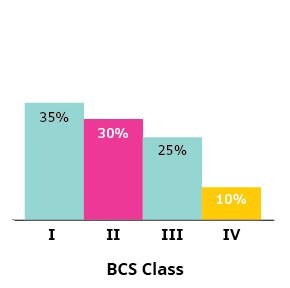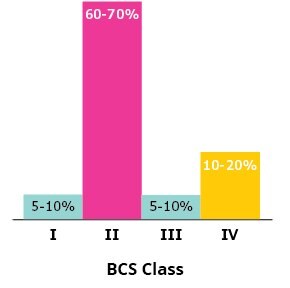How API Processing Can Help Improving API Solubility
Developing new active pharmaceutical ingredients (APIs) is lengthy and cost-intensive, thus it’s important to avoid any potential risk that may limit the product’s success. Today’s approach of high throughput screening and target-oriented drug discovery often results in challenging APIs that are poorly water soluble and unable to be commercialized.
Solubility and permeability are two important factors that correlate with in vitro and in vivo performance. The Biopharmaceutical Classification System (BCS) classifies APIs based on these characteristics into four groups (Figure 1):
- BCS Class I: High solubility and high permeability
- BCS Class II: Low solubility and high permeability
- BCS Class III: High solubility and low permeability
- BCS Class IV: Low solubility and low permeability

Figure 1.Biopharmaceutical Classification System classifies APIs based on solubility and permeability. BCS Class I: High solubility and high permeability; BCS Class II: Low solubility and high permeability; BCS Class III: High solubility and low permeability; BCS Class IV: Low solubility and low permeability
With an estimated share of 70–90% of drugs currently under development being poorly water soluble (BCS Class II and IV) (Figure 3), finding adequate solutions to address this challenge becomes increasingly important.
Current distribution of marketed drug substances

Figure 2.Current distribution of marketed drug substances among the different BCS classes.
Distribution of drug substances in the pipeline

Figure 3.Drug substances in the pipeline classified in the different BCS classes.
Why Is API Solubility Important?
API solubility is necessary for the final drug to succeed in terms of therapeutic efficacy. In the case of solid and liquid oral formulations, good API solubility is a prerequisite for sufficient absorption of the API by the body. If an API is insoluble, it cannot pass the gastrointestinal membrane and enter systemic circulation. Thus, their intended physiological effect will not be realized.
Liquid formulations typically require the API to be present in a dissolved form. Solubility is especially important for parenteral solutions which also need to be particle-free.
Improve API Solubility with API Processing Before Formulation
There are two routes available to improve API solubility (Table 1):
- Improving the API’s characteristics early in the development stage (API processing). API processing can enhance many API properties including solubility, processability, physical and chemical stability, and safety.
- Optimizing the formulation later in the development stage. This optimization is done through physical approaches.
While it is possible to successfully address solubility during formulation, addressing solubility early on eliminates surprises. There is no guarantee that adjusting the formulation will improve solubility to the level necessary for the desired administration route and therapeutic effect.
Methods for API Processing
Different solid forms of APIs exist which can be modified using different API processing methods (Figure 4).

Figure 4.Overview of solid forms of APIs which give an indication for potential API processing approaches.
Single-component solid drug forms are composed of only API molecules and can exist in their amorphous or crystalline form, potentially with different polymorphic forms (different crystalline forms of the same substance, often with distinct physicochemical properties). Multi-component solid drug forms are composed of several components, with at least one of them being an API and others non-active pharmaceutical ingredients. Like the single-component solid drug forms, multi-component solid drug forms can exist in their amorphous or crystalline form with potential polymorphs. Additional variations of crystalline multi-component solid drug forms include different hydrates/solvates, salts and cocrystals – depending on whether the other ingredient in the crystalline structure is water, solvent, counterion, or co-former molecules bound by non-ionic bonds and in a stochiometric ratio. All of these can exhibit different, desirable or undesirable, physicochemical properties. Screening techniques and API processing approaches open up a range of possibilities to modify the solid form of the API and tailor its physicochemical properties as required. Nano-milling can be applied broadly across API solid forms to reduce particle size and improve dissolution rate.

Salt Formation
Salt formation is a very effective method to increase solubility and dissolution performance of ionizable compounds. An ionized API is typically more soluble than non-ionized APIs. Finding the best API-counterion combination for salt formation is critical which is why the identification should happen as early as possible in the drug development process. Historically, hydrochloric salts (for basic APIs) and sodium salts (for acidic APIs) were predominant, but other counterions have been increasingly used in the past 30 years. This trend is expected to continue. Especially for poorly soluble actives, small hydrophilic counterions like citrates and acetates are very relevant. While poor solubility is the main reason for forming an API salt, other parameters like stability, toxicity, and processability can be positively influenced by this process.

Cocrystals
Cocrystals can be an alternative to salt formation if the API is non-ionizable. In this case a crystal structure is built by the API and a co-former, based on non-covalent bonding like van der Waals forces, hydrogen bonding, and others. Like salts, cocrystals have different properties from the original API including improved drug solubility, dissolution rate, bioavailability, physical and chemical stability, as well as processability. As the co-former remains in the final drug’s crystal structure, finding the right co-former in sufficient quality is key.

Polymorph Screening
Polymorphism of APIs describes the fact that the respective compound can exist in different crystalline forms2. Each polymorph has distinct physicochemical characteristics, hence influencing solubility, activity, and safety of the drug substance. Via different crystallization techniques and parameters (e.g. temperature and solvents), different polymorphic forms may be yielded.
Screening for polymorphs and obtaining information on the possible polymorphs is required for regulatory purposes. Polymorph screening early in drug development is important to identify the most suitable polymorph and avoid delays (if one finds out late in the process that a different polymorph is needed). Polymorph screening is also relevant for API salts as these also exhibit polymorphism.

Nano-Milling
In recent years, nano-milling gained significant importance as a technique to improve the dissolution rate of poorly water-soluble APIs. To maintain a small particle size of resulting nano-crystals and to prevent formation of aggregates, stabilizers are needed. Two mechanisms contribute to stabilization: steric stabilization, which can be achieved by adding nonionic polymers and nonionic surfactants, and electrostatic stabilization, which can be achieved by adding ionic surfactants. Dependent on the respective API, combinations of the above can be an option for enhancing long-term stability.
When you choose raw materials for API processing, consider the quality of material as well, purchase volume and supply, whether you’d be able to purchase low volumes during development and large volumes during manufacturing. Our broad portfolio supports different API processing techniques and formulation development steps and includes comprehensive documentation as part of the Emprove® Program.
For More Detailed Information on Improving API Solubility by Salt and Cocrystal Formation
- Download the white paper "Improving API Solubility by Salt and Cocrystal Formation"
- Watch the on-demand webinar "How to Improve API Solubility by Salt and Cocrystal Formation"
References
To continue reading please sign in or create an account.
Don't Have An Account?